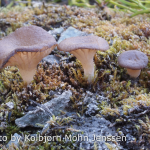Saprotrophic fungi degrade dead organisms or their remains, such as litter or dung. Depending on their mode of breaking down cellulose or lignin, we recognise brown rot fungi and white rot fungi. Brown rot fungi only breaks down cellulose (a carbohydrate chain polymer) and leaves lignin (a phenolic three dimension polymer) intact. The substrate becomes brown and brittle because of the colour and consistency of the remaining lignin. White rot fungi breaks down both cellulose and lignin. The substrate becomes pale, fibrous and soft. Saprotrophes also break down proteins and other complicated organic matters, releasing simple compounds containing nitrogen and phosphorus, which can be taken up by green plants. In the Arctic, degrading processes proceed slowly due to the cold and dry climate. Therefore, remains of plants and animals can persist for a very long time, a type of natural mummification. When conditions are not ideal (e.g. temperature and humidity) fungi reduce or stop decomposition and resume when conditions are favourable. Chytridiomycota, Mucoromycota, Ascomycota and Basidiomycota contain saprotrophic fungi.
Chytridiomycota, Mucoromycota and many Ascomycota can only be studied after culturing and isolating fungi from soil samples. Most saprotrophic Basidiomycota and some Ascomycota with large ascocarps can be easily monitored in field.
Wood inhabiting fungi are very rare in the Arctic as they are dependent on driftwood or manmade wooden structures. Due to their degrading strategies, some of these fungi are reported to be destructive in buildings. In Svalbard, Hyphocniciellum molle is an example of a harmful indoor brown rotter.
An interesting group of saprotrophs in the Arctic are fungi that grow on bryophytes. Their sporocarps usually grow directly from the moss shoot, which does not seem to harm the moss. This raises the question whether they are saprotrophs or specialised parasites. Examples are Arrhenia lobata, A. salina, Galerina arctica (all three Basidiomycota) and Bryoglossum gracile (Ascomycota). Arrhenia salina is specialised on mosses living by arctic seashores, thus climatically bound to this region.











